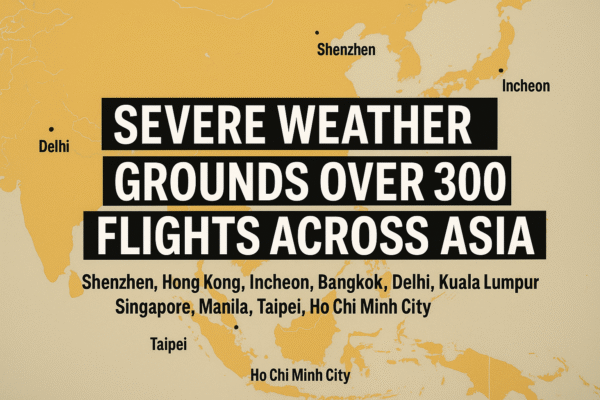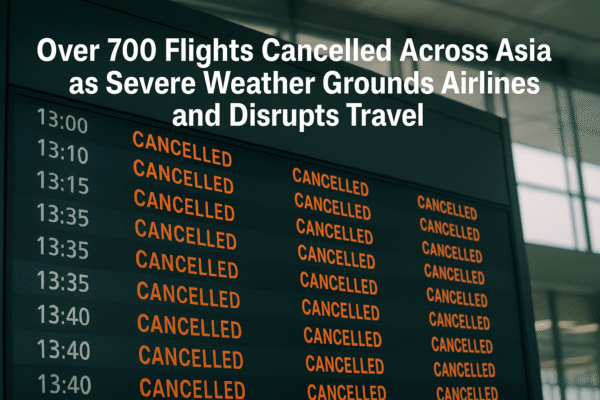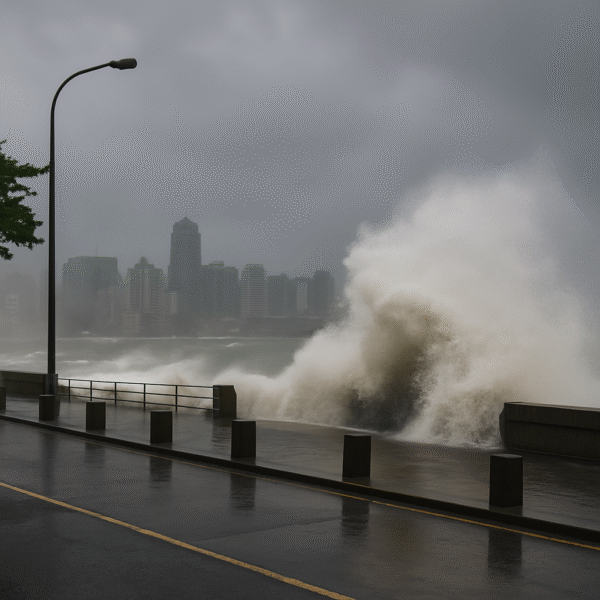July 21, 2025 — ASIA-PACIFIC — Asia’s aviation network was thrown into disarray today as severe weather systems triggered over 300 flight cancellations and hundreds more delays across major international airports in China, India, Hong Kong, South Korea, Thailand, Malaysia, Singapore, Vietnam, Taiwan, the Philippines, and Bangladesh.
Ferocious monsoon storms, lightning strikes, torrential rain, and low visibility conditions brought airports to a standstill, grounding global carriers including Singapore Airlines, Air India, Emirates, Korean Air, Cathay Pacific, Lufthansa, and VietJet Air.
Thousands of passengers were stranded as terminals overflowed and airport operations ground to a halt during what has been described by meteorologists as one of the most widespread storm systems of the year.
Country-by-Country Breakdown of Disruptions
🇨🇳 China
- Shenzhen Bao’an International: 201 delays, 116 cancellations.
China Eastern, Spring Airlines, Donghai Airlines hardest hit. - Shanghai Pudong International: 276 delays, 31 cancellations.
Major impacts on flights to the U.S., Japan, and Southeast Asia. - Shanghai Hongqiao International: 128 delays, 34 cancellations.
- Zhuhai International: 62 delays, 33 cancellations.
🇭🇰 Hong Kong
- Hong Kong International Airport: 211 delays, 75 cancellations.
Cathay Pacific alone cancelled 23 flights; major delays for Hong Kong Airlines, Korean Air, and Air Premia.
🇰🇷 South Korea
- Incheon International Airport: 257 delays, 9 cancellations.
Korean Air, Asiana, Jeju Air, and Emirates among impacted carriers.
🇮🇳 India
- Indira Gandhi International Airport (Delhi): 89 delays, 1 cancellation.
SpiceJet and IndiGo flights delayed amid monsoon turbulence.
🇹🇭 Thailand
- Suvarnabhumi Airport (Bangkok): 156 delays, 7 cancellations.
Flights by Thai Airways, SKY Angkor, Air Macau, and Vietnam Airlines disrupted.
🇲🇾 Malaysia
- Kuala Lumpur International Airport: 283 delays, 3 cancellations.
AirAsia had 147 delayed flights; Malaysia Airlines also affected.
🇸🇬 Singapore
- Changi International Airport: 182 delays, 1 cancellation.
Singapore Airlines, Scoot, Jetstar Asia, and Emirates reported major schedule interruptions.
🇵🇭 Philippines
- Manila Ninoy Aquino International Airport: 172 delays, 5 cancellations.
Philippine Airlines, PAL Express, and Cebu Pacific affected. - Francisco Reyes Airport (Busuanga): 9 delays, 2 cancellations.
🇧🇩 Bangladesh
- Shahjalal International Airport (Dhaka): 54 delays, 3 cancellations.
US-Bangla Airlines and Biman Bangladesh Airlines impacted.
🇻🇳 Vietnam
- Tan Son Nhat International (Ho Chi Minh City): 186 delays, 1 cancellation.
Vietnam Airlines, VietJet Air, and Jetstar Pacific flights delayed.
🇹🇼 Taiwan
- Taoyuan International (Taipei): 210 delays.
EVA Air, China Airlines, and Starlux all impacted. - Kaohsiung International: 56 delays, 2 cancellations.
Airlines Severely Affected
A mix of regional and global carriers saw operations halted or rerouted, including:
- Singapore Airlines
- Emirates
- Air India
- Cathay Pacific
- Air China
- Korean Air
- Lufthansa
- All Nippon Airways (ANA)
- Philippine Airlines
- Vietnam Airlines
- China Eastern
- AirAsia
- Jetstar Asia
- United Airlines
- Qatar Airways
- Scoot
- Juneyao Airlines
- Spring Airlines
International connectivity was seriously affected, with long-haul flights between Asia and Europe, North America, and Australia disrupted.
Weather Systems Behind the Crisis
Meteorological agencies across the region confirmed that tropical depressions, monsoon troughs, and coastal low-pressure systems triggered the widespread disruption.
Key weather issues included:
- Sudden wind shear and air turbulence
- Runway flooding
- Lightning proximity alerts
- Power outages at several air traffic towers
- Reduced visibility due to heavy cloud cover
The India Meteorological Department (IMD) and the Hong Kong Observatory issued multiple severe storm warnings, while Taiwan’s Central Weather Administration and Vietnam’s National Center for Hydro-Meteorological Forecasting continued to monitor developing systems in the South China Sea.
Urgent Advice for Travelers
Passengers planning travel through affected regions are strongly advised to:
- Check flight status regularly on airline apps and websites.
- Arrive early at the airport to allow extra time for check-in and security.
- Monitor regional weather alerts and advisory notices.
- Stay flexible with travel plans and expect potential overnight delays.
- Keep essentials on hand including chargers, toiletries, and medications.
Most airlines have issued fee waivers for rebookings and cancellations, including Singapore Airlines, AirAsia, Emirates, and Korean Air.
A Wake-Up Call for Asian Aviation
This latest weather-related collapse adds to growing concerns about Asia’s vulnerability to climate-driven disruptions. With storm activity intensifying across the Pacific and Indian Oceans, the region’s aviation systems face mounting pressure to:
- Upgrade weather prediction and early-warning technologies
- Enhance cross-border communication between ATC centers
- Improve real-time passenger information systems
- Build resilient airport infrastructure to handle flood risks
Travel experts also urge airlines to invest in climate contingency planning to protect both passengers and schedules from increasing volatility.
Final Thought
Today’s storm-linked cancellations are the latest example of how climate instability is directly impacting global travel. As Asia’s most prominent airports—from Shenzhen and Incheon to Singapore and Manila—struggle to recover from one of 2025’s most severe travel disruptions, passengers and airlines alike are reminded that weather resilience is now a key metric for operational success.
Until conditions stabilize, travelers are encouraged to stay informed, stay calm, and prioritize safety while navigating this temporary but turbulent setback in Asia’s travel network.
For more travel news like this, keep reading Global Travel Wire





















